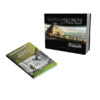No products in the cart.
Return To ShopNoah’s Flood: How Could the Ark Have Been Seaworthy?
Was Noah’s Ark Seaworthy?
Let’s investigate whether the Ark was seaworthy. God gave certain dimensions to Noah for building the Ark: 300 cubits long, 50 cubits wide, and 30 cubits high. Using the Nippur Cubit[i] at 20.4 inches, this works out to a vessel about 510 feet long, 85 feet wide, and 51 feet high. Accounting for a 15% reduction in volume due to the hull curvature, the Ark had about 1.88 million cubic feet of space, the equivalent of 450 semi-trailers of cargo space.[ii] Twice as long as a Boeing 747 and stretching over one-and-a-half football fields, this was a massive ship.
God knew exactly what He was doing when He gave Noah the specific dimensions of the Ark. In 1993 Dr. Seon Won Hong conducted a scientific study[iv] to investigate the seaworthiness of the Ark at the renowned ship research center KRISO (now called MOERI) in South Korea.[v] After evaluating the seaworthiness of over 10 various ship dimensions, the study showed that the Ark dimensions given in the Bible were ideal for handling everything a highly turbulent sea could throw at it, while balancing the need for inhabitant safety. The study showed that the Ark could handle 100-foot waves.
An earlier study conducted in the 17th Century by Peter Jansen of Holland showed that the length-to-width ratio of the Ark (about 7-to-1) was ideal for such a massive, non-powered sea vessel. Some oil tankers have a 7-to-1 ratio as well. He also demonstrated using replica models of the Ark how tough it was to capsize.[vi]
Noah was instructed by God to coat the inside and the outside of the Ark with pitch, a thick gooey substance secreted by trees as a means of protection against infection or insect attack. Isn’t it interesting that one of the very first historical references to using pitch for ships is in the Bible? It’s also interesting that pitch has been the most effective and widely-used ship waterproofing substance in history. For centuries, tar, which is made from pitch, was among Sweden’s most important exports, peaking at over a quarter million barrels per year in the late 1800s. Many of the eastern states in the U.S. were also major tar exporters for ship building purposes until the 1900s.[vii]
When heated into a liquid state and applied to ship planking, pitch hardens almost instantly into a protective, waterproof shell, very similar to how epoxy or fiberglass are used in shipbuilding today. The strong outer shell provided by hardened pitch adds both strength and waterproofing beyond the natural capability of the wood. These “divine shipbuilding instructions” given to Noah certainly seem to make realistic sense.
Noah’s Ark vs. the Gilgamesh Ark
Now let’s compare the Biblical Flood to the leading flood myth, the Epic of Gilgamesh. In 1853, archaeologists found a series of 12 tablets dated to around 650 BC, although parts of the story existed in earlier, fragmentary versions.[viii] Because the story had many of the same elements as the Genesis account, skeptics believed that Gilgamesh preceded the Biblical account, negating the Genesis account as just a spin-off. Fortunately for Christians, however, there are major clues that point to the Biblical account as the accurate one, and Gilgamesh as a later work of fiction that incorporated legendary elements of a flood within a cultural fantasy. Here are the reasons why.
First, we have the feasibility of the Gilgamesh version of the Ark, described as a massive, unstable cube that was about 200 feet on each side with six decks that divided it into seven parts. Along with help from the community and craftsmen, he supposedly built this vessel—which was over three times the size of the Biblical Ark, in just a week.
How would something like this fare during a catastrophic, worldwide Flood? It would obviously tumble, killing or maiming its passengers. That’s obviously quite different than the biblical Ark which had a 7-to-1 length-to-width ratio which is very similar to many of today’s ocean barges, making it a feasible design for staying afloat during the Flood. Scripture provides clues that Noah and helpers likely had between 55 and 75 years to build the Ark.[x]
The second key for determining which of these Flood accounts is the original is the duration of the Flood provided by each. The Gilgamesh flood lasted a mere six days, whereas the Genesis Flood lasted 371 days. Both accounts claim the Flood was worldwide, but how could water cover earth in just six days? A floating, 200 X 200 X 200-foot cube and six days for worldwide inundation certainly stretch credulity.
The next consideration is the reasons for the Flood given by each of the two accounts. In the Genesis account, God’s judgment is just—he was patient with utterly wicked mankind for 120 years before sending the Flood and showed mercy to the last righteous family. In the Gilgamesh account, the Flood was ordered by multiple, self-centered squabbling ‘gods’ that were ‘starving’ without humans to feed them sacrifices. These two are quite different!
Finally, there are several other parts of the Gilgamesh account that are obviously mythical, such as Gilgamesh being 2/3rds divine and 1/3rd mortal. After oppressing his people, Gilgamesh and others call upon the ‘gods’ and the sky-god Anu creates a wild man named Enkidu to fight Gilgamesh. The battle is a draw, and they become friends. Gilgamesh apparently also encounters talking monsters and a “Scorpion man” in his journeys.
Scholars rely on their anti-Bible bias, not science, to assert that the Gilgamesh story came first. These stark differences between Genesis and Gilgamesh accounts highlight the feasibility and priority of the biblical one. The Gilgamesh account was written 800 years[xi] after Genesis and describes a cube-shaped Ark 200 feet on each side tumbling around in the ocean in a 6-day flood put on by the “angry, fighting gods” that sent it. The Bible’s Flood was recorded earlier, has an Ark sealed on the inside and out with dimensions that are on par with today’s ocean liners, lasted a full year, and was sent to judge an Earth that deserved it.
In fact, it’s the similarities between these two accounts that shows the Bible’s account to be the historical one. Many myths are based on historical accounts, but they get embellished over time, becoming more and more mythical as the story is repeated over generations. This is exactly what we see with flood myths like Gilgamesh—they take the original, historical account (the Biblical Flood) and grow it into a mythical, interesting story over time.
For example, the earlier version of the Gilgamesh Flood account[xii] clearly identifies the flood as a local river flood, with the dead bodies of humans filling the river “like dragonflies” and moving to the edge of the boat “like a raft” and moving to the riverbank “like a raft.” Centuries later, this gets exaggerated into a global, worldwide flood where humans killed in the flood “fill the sea” like a “spawn of fish.”
Both accounts have a God or “gods” that are sending judgment, describe a worldwide inundation, have an Ark built to specific dimensions that are loaded with surviving humans and animals, and land just a few hundred miles apart from each other after using birds as a test to find dry land. Myths often grow from historical to being more mythical, but they almost never develop in the reverse, becoming more truthful and accurate over time. While these accounts mirror each other in so many ways, which account is the original, historical one? The feasible one of course. While both accounts describe plenty of divine intervention, only the Biblical ark size, shape, function, build time, and flood duration makes sense.
Jesus taught about a real flood and compared it to what the end times will be like. Jesus warned: “But of that day and hour no one knows, not even the angels of heaven, but My Father only. But as the days of Noah were, so also will the coming of the Son of Man be. For as in the days before the flood, they were eating and drinking, marrying and giving in marriage, until the day that Noah entered the ark, and did not know until the flood came and took them all away, so also will the coming of the Son of Man be.”
Because Jesus stood firmly on the historicity of the Flood and likened it to end times (Matthew 24:36–44), the two go hand-in-hand. If the Genesis Flood never happened, we have no foundation for believing in the rest of what Jesus said, including His second coming. At least for Christians, Matthew 24 alone should destroy the “Flood as myth” idea. When looking back through history, we observe that some mythical accounts begin with a true event, but then get embellished over time, becoming more and more mythical.
[i] Answers in Genesis: “Putting the Ark into Perspective” (January 23, 2014): https://answersingenesis.org/noahs-ark/putting-the-ark-into-perspective/
[ii] Michael Belknap and Tim Chaffey, “How Could All the Animals Fit on the Ark?” (April 2, 2019): https://answersingenesis.org/noahs-ark/how-could-all-animals-fit-ark/
[iii] John Woodmorappe, “Chapter 5: How Could Noah Fit the Animals on the Ark and Care for Them? (October 15, 2013; last featured March 2, 2014): https://answersingenesis.org/noahs-ark/how-could-noah-fit-the-animals-on-the-ark-and-care-for-them/
[iv] Dr. Hong earned his Ph.D. degree in applied mechanics from the University of Michigan, Ann Arbor.
[v] S.W. Hong, S. S. Na, B.S. Hyun, S.Y. Hong, D.S. Gong, K.J. Kang, S.H. Suh, K.H. Lee, & Y.G. Je, “Safety investigation of Noah’s Ark in a seaway,” Creation.com: www.creation.com/safety-investigation-of-noahs-ark-in-a-seaway (January 1, 2014).
[vi] John Whitcomb, The World that Perished (Grand Rapids, Michigan: Baker Book House, 1988): 24.
[vii] Y. Eyüp Özveren Shipbuilding, 1590–1790, Vol. 23, No. 1, Commodity Chains in the World-Economy, 1590–1790 (2000), 15–86.
[viii] Frank Lorey, The Flood of Noah and the Flood of Gilgamesh
(March 1, 1997): https://www.icr.org/article/noah-flood-gilgamesh/
[ix] Tim Lovett, “Comparing Gilgamesh,” (October, 2004) (https://worldwideflood.com/ark/gilgamesh/gilgamesh.htm#gilgamesh).
[x] Gotquestions.org: https://www.gotquestions.org/Noahs-ark-questions.html; Ark Encounter, “How Long for Noah to Build the Ark?” (November 18, 2011): https://arkencounter.com/blog/2011/11/18/how-long-for-noah-to-build-the-ark/;
Verse by Verse Ministry:
https://www.versebyverseministry.org/bible-answers/how-long-did-noah-take-to-build-the-ark; Bodie Hodge, “How Long Did It Take for Noah to Build the Ark?” (June 1, 2010; last featured May 23, 2018):
https://answersingenesis.org/bible-timeline/how-long-did-it-take-for-noah-to-build-the-ark/
[xi] Previous similar versions (in fragmentary form) exist that have been dated earlier.
[xii] Jeffrey H. Tigay, “The Evolution of the Gilgamesh Epic,” University of Pennsylvania Press, Philadelphia, 1982, 220, 225.









